The evolution of digital collections
Digital collections have evolved through three distinct generations to where they are today. We now see a fourth stage on the horizon, enabled by new AI tools that will make ever-more personalised interactions with digital collections possible.
As a digital agency for many of the UK’s leading GLAM organisations (galleries, libraries archives and museums), we love digging into how new tech can be applied to improve both the visitor experience, both onsite and online.
Our recent blog post on How Museums could be using AI talked about the possibilities that generative AI may offer the sector. At the 2023 Museum+Tech conference, we spoke about some of these ideas, and how they fit into a wider context of GLAM organisations needing to widen participation in their collections, making them more relevant to more people in more ways.
We mapped out how digital collections interfaces have evolved; from the brutalist search interfaces of the 1990’s to the much more immersive and discoverable experiences we have today. We considered how people interact with these different interfaces and how the amount of content your editorial teams need to generate has grown over time. We question the sustainability of this trajectory and consider the role of generative AI in content creation as an ‘assistive layer’ to augment busy editorial teams.
Generation one: accessible and searchable
Digitisation of collections in the late 90s and early 2000s made a wealth of cultural material available online. These records were accessed via search, which was a huge leap forward at the time.
Accessing the collections via search was great for researchers and experts, but it could be intimidating for the public who wanted to explore more generally and might not have had a specific search term in mind.
This meant the digital collection’s audience was small, and with content being just what was already held in the catalogue, the burden of content creation was also minimal.
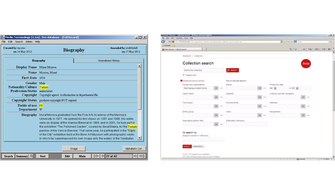
Generation two: browsable and engaging
The drawbacks of the ‘search only’ interface led to museums and archives thinking about new ways to let users explore their collections, opening them up to a wider audience.
The paper ‘Generous Interfaces for Digital Cultural Collections’ in Digital Humanities Quarterly called for a new approach with a more generous interface: “Keyword search is ungenerous: it demands a query, discourages exploration, and withholds more than it provides. This paper argues instead for generous interfaces that better match both the ethos of collecting institutions, and the opportunities of the contemporary web. Generous interfaces provide rich, navigable representations of large digital collections; they invite exploration and support browsing”.
A new generation of interfaces for digital collections was already evolving to encourage exploration and browsing.
Way back in 2011, we worked on a project like this with the BBC and the Public Catalogue Foundation. We made a website for the ‘Your Paintings’ collection that showcased 200,000 of the UK’s publicly owned oil paintings. This interface offered much more than a simple search-only design, inviting users to explore the collection using new and (at the time) innovative ways.
Users could browse by artist, make their own collections, and take virtual tours collated by famous faces. This helped to bring the collection to life for non-experts, and was a far more welcoming experience, providing new and exciting ways to interact with the content. It made the collections far more accessible to a mainstream audience. However, producing more ways to explore the content required far more editorial effort from the institution.
Many digital collections are still at this stage. Some, however, have gone further to be able to tell stories through collections of objects, which brings us on to generation three.
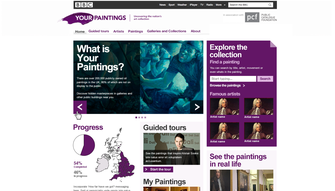
Generation three: Telling a story
Museums have always known that the stories that connect the objects are as important as the individual objects themselves. A great exhibition is much more than just the sum of the objects it has on display. It is the careful choice of objects and how they are connected to tell a story.
This approach is now also being applied to how users experience online collections. Objects can be tied together to tell engaging stories, making them more accessible to new audiences.
We created The Science Museum’s ‘Objects and Stories’ section to let users discover objects from their collection based on their interests, accessing stories that tie objects together around a central theme. For example, their ‘Astronomy’ section highlights key objects that tell the story of the development of astronomy, from 1,000-year-old Islamic astrolabes to Edo period Japanese star maps, right up to the radio telescopes of today. We’ve done similar work to allow museums to tell stories with objects for the Royal Armouries and British Museum too.
Museums can create stories around contemporary topics, utilising the collection to tell stories of our society and history, such as the Science Museum’s series of stories on Women in Science.
Generation three is essentially the current frontier for how to present digital collections, but we believe a fourth generation is now on the horizon.
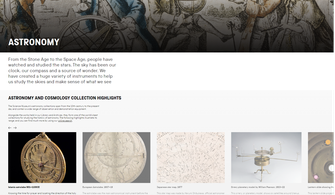
Generation four: Tell me my own story
The Museum’s Association has found that a current challenge for the GLAM sector is to increase the reach, relevancy and meaningfulness of their collections so that they resonate more broadly with increasingly diverse audiences. An interesting question, is whether a single interpretation of a collection will meet the diverse needs of these different audiences?
Delivering new, multiple and dynamic interpretations will require even more work from content curators, and at some point, this may well become unsustainable for content teams working in GLAM organisations.
However, the latest developments in LLMs (large language models) opens the possibility of effectively infinite personalisation, as AI agents create personal collations and explanations of objects in digital collections tailored to a user’s exact needs. The technology might not be ready to deploy with users quite yet without human moderation, but we believe that day is coming very soon.
We conducted a quick test using the new create your own GPT functionality of open AI’s GPT 4. Our custom Science Museum GPT was given instructions and examples for how to interpret the Science Museum’s collection to tell the story of modern-day computing.
It can be given tasks like, ‘create an interpretation for an 8-year-old child’ or ‘create an interpretation for a computer science graduate with an interest in cryptography’. These prompts lead it to collate different collections of objects and tailor the content based on the audience. For example, the story of computing for an 8-year-old begins with an abacus, while for a computer science graduate it starts with Charles Babbage’s Difference Engine. These tools could create a unique interpretation of the collection based on a single user’s interests in real-time.
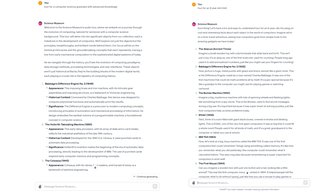
Shaping the future of digital collections
Working as innovators in the digital collections space, we will always be looking for new interfaces that improve how your audiences discover and explore your digital collections, whilst considering the workload this creates for your content teams. As a sector, we need to also consider how these AI systems can be utilised in a way that is trustworthy and accurate.
It’s clear that these AI tools offer the sector exciting possibilities for increasing engagement with digital collections. If you work in the GLAM sector and you’d like help exploring how to use AI to bring your collection to life, we’d love to be involved. Contact [email protected] and let’s chat about what you’ve got in mind.
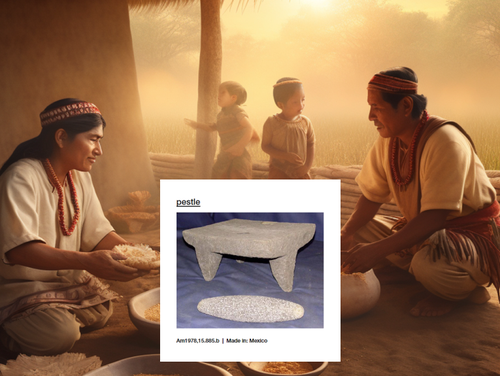
AI can be a powerful tool for museums, both for curation and to bring objects to life. We wanted to share our ideas for how museums can use this new technology to delight visitors and enhance their experience.